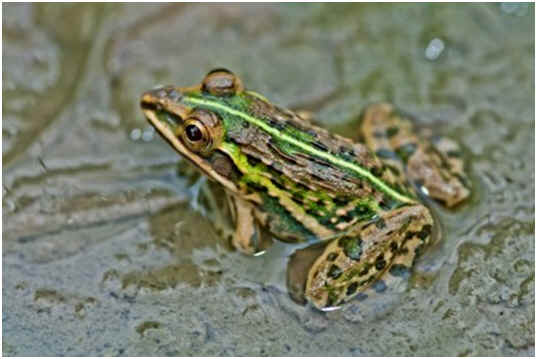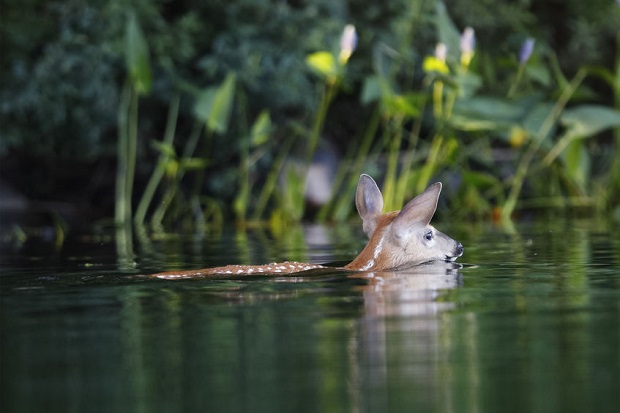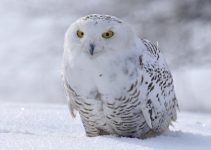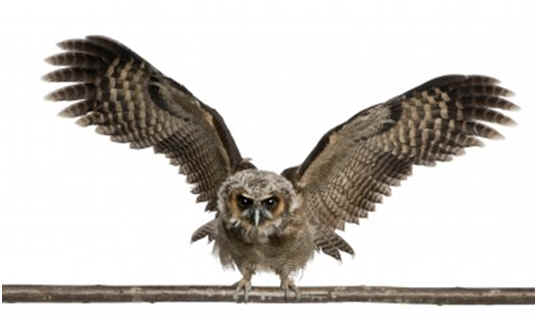
Can Owls Fly?
Owls can fly and, in fact, are unique from other birds because they are silent fliers.
Body Adaptations Needed for Flight
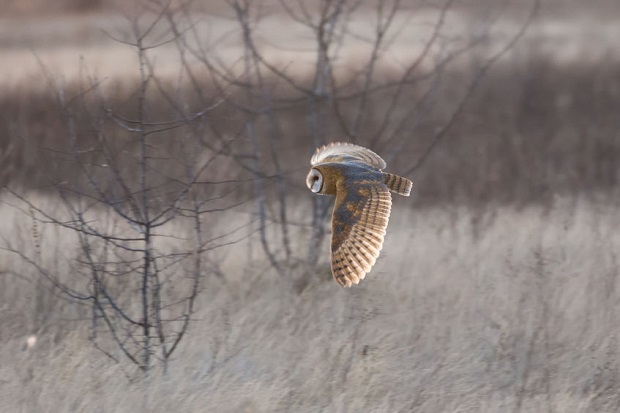
Whether considering the great grey owl with an impressive wingspan of 5 feet or the tiny elf owl with a wingspan of only 15 inches, the owl’s body is perfectly adapted to achieve flight. For anything that is heavier than air to achieve flight, two things are necessary—they must have power and strength, and they must be lightweight. The owl’s body is adapted to accommodate both. [WVU]
Light Weight: The owl’s body has adapted in several ways to reduce the weight of its body. For example, many of its skeletal system’s bones are pneumatic, meaning they are hollow and contain air sacs. Others are spongy or strutted. They are also missing bones that other vertebrae share, such as teeth, tail, finger, and leg bones.
Another interesting adaptation that keeps a bird light is the organs of the reproductive system are minimized in the body until they are needed. During the breeding season, the reproductive system will fully develop to normal size. [Stanford]
They also do not have a urinary bladder.
Power and Strength: The owl’s body is adapted for flight in several ways that power the bird with strength. For example, the bird’s skeletal system offers rigid support because the vertebrae and girdles are fused. It also has a very large breast muscle, which powers the wings downstroke, making up 25-40% of the bird’s total body weight.
Because most aerobic biochemical reactions depend on temperature, the bird’s body temperature also plays a role in its ability to fly. A bird’s body temperature runs at 40-43°C, higher than that of mammals, which generates sustainable and rapid power production.
The respiratory system is possibly the most important adaptation that is necessary for the bird to achieve and maintain flight. In fact, the bird devotes one-fifth of its body volume to its large, complicated respiratory system, whereas, in contrast, mammals’ respiratory systems comprise only one-twentieth. [Swanson]
Newton’s Third Law Behind Owl Flight
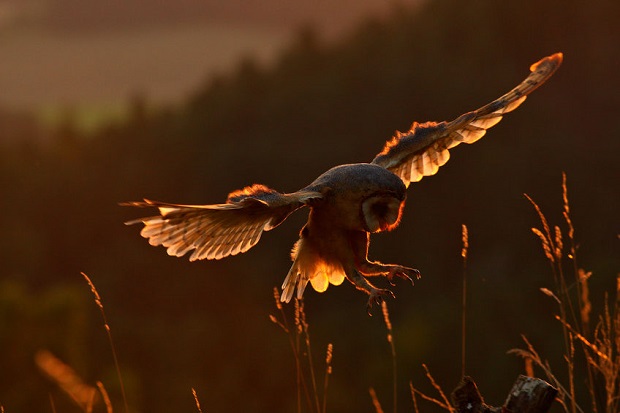
An owl flies using Newton’s third law of motion, which states that for every action, there is an equal and opposite reaction. On the downward stroke of a bird’s wing, it pushes air downward. According to Newton’s law, forces result from mutual interactions, so the air must then push the bird upwards. [Physics Classroom]
This lift is further assisted by the shape and curvature of the wing, creating a shape called an airfoil. As the owl soars through the air, the air is split above and below the wing. The air above the wing travels faster than it does below, which increases the pressure below. Since high air pressure moves toward low pressure, the wing in the middle is lifted. When the force of the lift is greater than the force of gravity, the bird can fly. [Boeing]
The bird’s wing is also hinged so that it can also thrust forward and, on the upstroke, can pull the wings into the body to avoid the same principles pushing it back downward. [University of Illinois]
How Owls Fly Silently
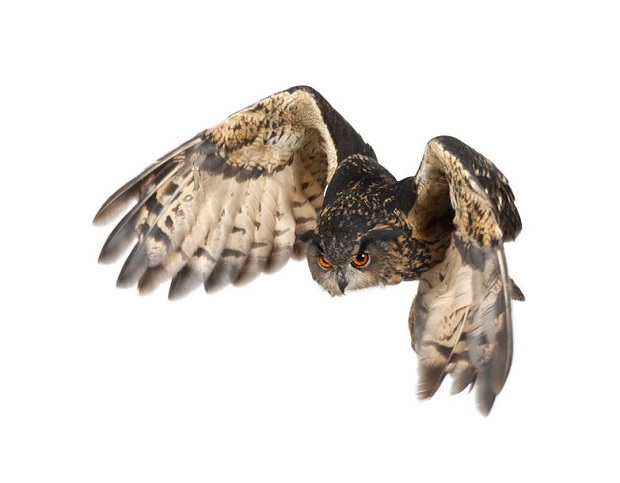
But wait. Now that we understand how birds can fly let’s take a look at how the flight of an owl is unique from other bird species. When birds fly, the air rushing over their wings creates turbulence, which contributes to the wooshing sound they make as they soar through the air. Owl’s flight is silent. This noiseless flight can be credited to three physical attributes of its unique wing structure. First, the leading wing feathers are serrated, which helps to reduce noise during flight. Next, the trailing feathers at the wing’s trailing edge are fringed. Finally, the entire wing surface is covered with a velvety downy surface, absorbing sound. [Jaworkski]
When an owl flies, it generates noise at frequencies below 2kHz, which makes the owl inaudible to its prey of mice and voles, which hear at frequencies between 2-20kHz. [Lilley, G]
Owls Use Flight in Mating Rituals
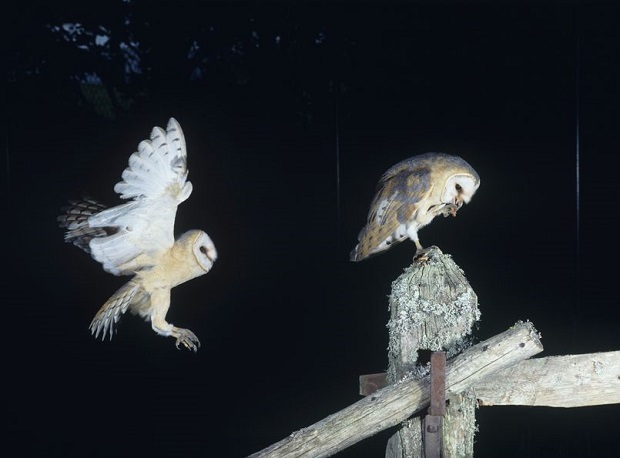
Depending on the species, flying is an important part of the owl’s mating ritual. For example, the male northern saw wet owl will circle its intended mate up to twenty times before presenting her with fresh prey. The barn owl will give his intended mate a showy flight display and then hover before her in a ritual called the ‘moth flight.’ [Cornell] [Cornell]
Resources
West Virginia University Cooperative Extension
Night Birds: Owls
http://anr.ext.wvu.edu/r/download/48152
Stanford University
Adaptations for Flight
http://www.stanford.edu/group/stanfordbirds/text/essays/Adaptations.html
Swanson Dr., David; University of North Dakota
Introduction/Adaptations for Flight
http://sunburst.usd.edu/~dlswanso/ornith/lec1_2.html
König C, Weick F (2008)
Owls: a guide to the owls of the world.
Second Edition. Robertsbridge: Pica Press.
University of Illinois Department of Physics
How Do Birds Fly?
http://van.physics.illinois.edu/qa/listing.php?id=760
Physics Classroom
Newton’s Third Law
http://www.physicsclassroom.com/class/newtlaws/u2l4a.cfm
Boeing
What Is an Airfoil?
http://www.boeing.com/companyoffices/aboutus/wonder_of_flight/airfoil.html
Jaworski, J; American Physical Society
Vortex Noise Reductions from a Flexible Fiber Model of Owl Down
http://absimage.aps.org/image/DFD13/MWS_DFD13-2013-002069.pdf
Lilley, G; American Academy or Aeronautics and Astronautics, Inc.
A Study of the Silent Flight of the Owl
ICASE, NASA, Langley Research Center, Hampton, Virginia
http://arc.aiaa.org/doi/abs/10.2514/6.1998-2340
The Cornell Lab of Ornithology
Norther Saw-whet Owl
http://www.allaboutbirds.org/guide/northern_saw-whet_owl/lifehistory
The Cornell Lab of Ornithology
Barn Owl
http://www.allaboutbirds.org/guide/barn_owl/lifehistory


